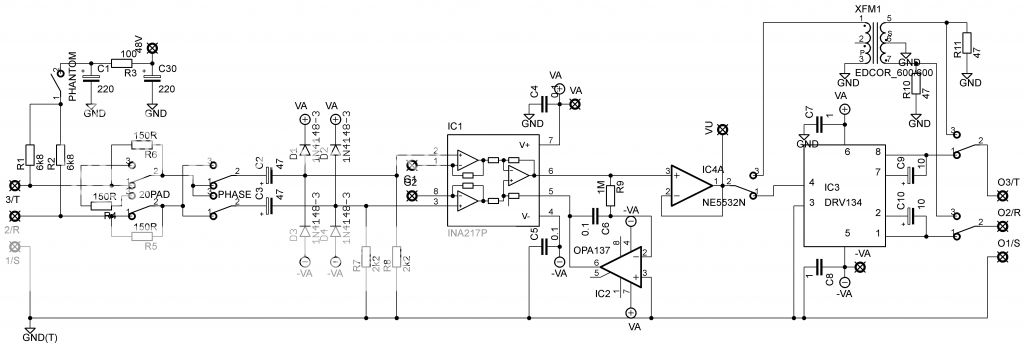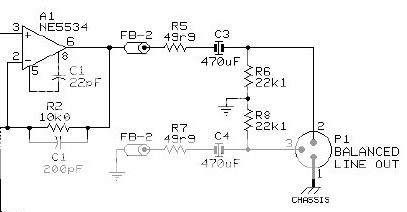Hello! First post on this forum, I look forward to spending more time here.
I had thrown together an INA217 preamp a while back and thought it was OK. It got given away or lost in a bunch of moves, but I recall enjoying it. I'm thinking about building another one, but adding on an output transformer for a balanced out. I have read and understand this can be done simply with opamps, but I thought an output transformer might add a different sound to the mix.
The INA217 datasheet is here along with the basic mic preamp schematic in figure 4: http://www.ti.com/lit/ds/symlink/ina217.pdf
I'm not sure the output DC control loop from figure 4 would be necessary, but besides that, I'm not totally sure if the INA217 could drive a transformer. Even less, I'm not sure what type of transformer would be needed. This would be used almost exclusively into line inputs of 10k on modern USB sound interfaces. Could be interesting to switch between a transformer coupled balanced output and an opamp driven one.
Any suggestions of schematics to look at, transformers to get and where to get them (relatively inexpensive to go with the INA217 spirit), and any of the details about why a transformer might or might not work in this situation would be much appreciated.
Thanks for your help!
I had thrown together an INA217 preamp a while back and thought it was OK. It got given away or lost in a bunch of moves, but I recall enjoying it. I'm thinking about building another one, but adding on an output transformer for a balanced out. I have read and understand this can be done simply with opamps, but I thought an output transformer might add a different sound to the mix.
The INA217 datasheet is here along with the basic mic preamp schematic in figure 4: http://www.ti.com/lit/ds/symlink/ina217.pdf
I'm not sure the output DC control loop from figure 4 would be necessary, but besides that, I'm not totally sure if the INA217 could drive a transformer. Even less, I'm not sure what type of transformer would be needed. This would be used almost exclusively into line inputs of 10k on modern USB sound interfaces. Could be interesting to switch between a transformer coupled balanced output and an opamp driven one.
Any suggestions of schematics to look at, transformers to get and where to get them (relatively inexpensive to go with the INA217 spirit), and any of the details about why a transformer might or might not work in this situation would be much appreciated.
Thanks for your help!
Perhaps something like this from EDCOR would work?
https://www.edcorusa.com/wsm150-150
However, I had read on another forum that the output impedance of the INA217 is somewhere around 100ohms, so perhaps it would be better to use a transformer like this:
https://www.edcorusa.com/wsm10k-600
Unless I have totally messed up the idea of impedance in my mind, the output impedance should be lower than the input, so the ~100ohm output into the 10k of the transformer, then the 600 ohm output impedance of the transformer into the 10k input impedance of the line in on a sound card.
Couldn't be that simple, could it? Or perhaps using the 600:600 version and drive it with an opamp balanced driver would be better?
Thank you
https://www.edcorusa.com/wsm150-150
However, I had read on another forum that the output impedance of the INA217 is somewhere around 100ohms, so perhaps it would be better to use a transformer like this:
https://www.edcorusa.com/wsm10k-600
Unless I have totally messed up the idea of impedance in my mind, the output impedance should be lower than the input, so the ~100ohm output into the 10k of the transformer, then the 600 ohm output impedance of the transformer into the 10k input impedance of the line in on a sound card.
Couldn't be that simple, could it? Or perhaps using the 600:600 version and drive it with an opamp balanced driver would be better?
Thank you
The catch is that a 10k to 600 xmfr inevitably is a 4:1, i.e. you're losing 12 dB. Jensen has 2k4 to 600 ohm types, whose 6 dB loss one may be able to live with more easily. Otherwise a 600 ohm to 600 ohm type would be the one to look at - still reasonably easy to drive but also still suitable for substantial lengths of cable.
The INA217 would seem a little bit too weak for obtaining full output level into 600 ohms though, and since output impedance is not precisely known anyway, I would recommend a buffer at the very least. Something like a NE5532 follower with both sections combined via 47 ohm resistors. Two more of these resistors from ground to the "cold" output, and you have a simple but perfectly fine balanced output that also connects to unbalanced inputs if need be (otherwise you'd need a floating balanced output in order to pull that feat).
A xmfr tends to appreciate low driving impedance, too, at least when it comes to distortion.
The INA217 would seem a little bit too weak for obtaining full output level into 600 ohms though, and since output impedance is not precisely known anyway, I would recommend a buffer at the very least. Something like a NE5532 follower with both sections combined via 47 ohm resistors. Two more of these resistors from ground to the "cold" output, and you have a simple but perfectly fine balanced output that also connects to unbalanced inputs if need be (otherwise you'd need a floating balanced output in order to pull that feat).
A xmfr tends to appreciate low driving impedance, too, at least when it comes to distortion.
Thank you for the reply, sgrossklass!
I don't quite understand this part:

I don't quite understand this part:
What are both sections and the cold output? I have the schematic below that I'm working on. I added R10 and R11 off the transformer outputs, is that what you are referring to? Also a simple 5532 buffer after the INA217. Thanks for your advice!with both sections combined via 47 ohm resistors. Two more of these resistors from ground to the "cold" output,

No, R10/11 don't make any sense like that, you can remove them again. Since you already have a DRV134 in there, you won't need the "poor man's balanced output" that I described. This is along the lines of what I meant, sans combining:

BTW, I'd make R3 a bit bigger still, maybe 330-470 ohms, or even 1k.
And as shown above, XLR pin 1 goes directly to CHASSIS (not local circuit ground).

BTW, I'd make R3 a bit bigger still, maybe 330-470 ohms, or even 1k.
And as shown above, XLR pin 1 goes directly to CHASSIS (not local circuit ground).
- Status
- This old topic is closed. If you want to reopen this topic, contact a moderator using the "Report Post" button.